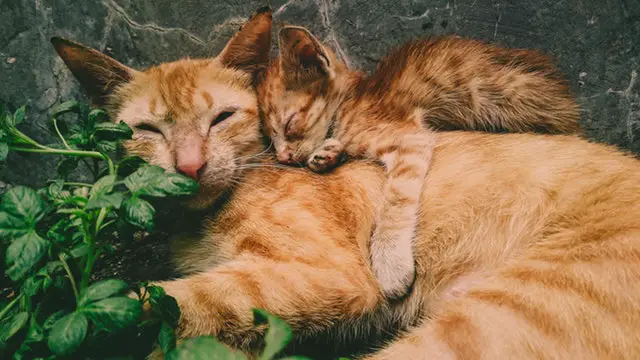Cats and dogs are undoubtedly the closest domestic animals to man, especially cats have been living with man since time immemorial, serving as a companion animal. It is to be expected then that everything related to the pregnancy of cats is of great interest to their owners.
In this article you will be able to know all the details about cat gestation, how long the rutting period lasts, the gestation time, the average number of kittens at birth, and much more information about the reproduction of cats in general. This will allow you to monitor your cat’s pregnancy properly and provide the care it needs to achieve its entire litter.
Reproductive Characteristics of Cats
The time felines reach sexual maturity varies depending on gender. In the case of male cats, it usually occurs about 6 or 7 months of life, while female cats are generally suitable at 4 or 5 months to reproduce.
Like other females in the class of mammals, the cat has a heat period (this is also called the estrus period) that can occur several times a year, with an average duration of 7 days. Animal owners may find that the cat is in heat for her behavior, is generally more affectionate than usual, rubs against objects around her, and meows frequently. These signs are observable even in the days before heat, but with less intensity.
When they live in colonies, it is common for males to compete for the right to copulate with a cat, so the winner is the one who takes the prize. When a male tries to mate with a cat, it is normal for it to resist, so the male will try to immobilize it by biting it on the back of the neck. During penetration, the female can feel pain, and this is due to the anatomy of the male’s peni.s, which has tips at the front that allow it to stimulate female ovulation when they come into contact with the vagin.a. These reproductive characteristics are common in other animals such as the lion.
A curious characteristic about the reproduction of cats is that cats can mate with several males during the same ovulatory phase, resulting in the offspring of the same litter often having different parents.
When the estrus elapses and fertilization of the cat has not occurred, it passes into a phase that is known as diestrus, in which the female must ovulate normally. The last phase of the reproductive cycle of cats is the anestrus, which is basically resting and can last up to 90 days.
Cat Gestation Period
How Long is a Cat Pregnant?
Cats have an average gestation period of 65 days. The gestation period in cats is 63 to 67 days from the first day of mating.
The extension or decrease of this gestation period may be influenced by the breed of the feline, as is the case of Siamese cats that can have a prolonged pregnancy of up to 70 days. It can also influence the number of kittens in the litter. The greater the number of kittens, the shorter the gestation period of the cat and vice versa. As cats can suffer psychological stress, any environmental factor can also lead to the early or late birth of kittens.
☛ Check This Out: Cat Gestation Calculator and Chart
Cat Pregnancy
First of all, we must say that responsible pet ownership today is essential, so that the pregnancies of our pets must be properly planned or if we are not interested in having children, they must be sterilized on time.
Signs of Pregnancy in Cats
Some signs can alert you that your cat is pregnant, although they will not be very evident until the third or fourth week of gestation. The change of coloration and the swelling of the breasts are the most important visible symptoms that you will observe in this period. Regarding behavior, you can notice an ambivalence that will depend on how the pregnancy hormones affect the animal, some females are prone to become irritable and solitary, while others become more affectionate and sociable with their owners.
As the young begin to grow in the mother’s womb, it will gradually increase in size. To avoid the extra effort that travel requires, the expectant mother needs to have food and a container of water on hand. A vet will be able to advise you of the changes in the diet that you must introduce at each moment of the pregnancy, since for a good fetal development the mother will need a greater caloric intake and the consumption of vitamins.
Given the suspicion that we have a pregnant cat at home, we should go to the vet to confirm the diagnosis; ideally, during the entire duration of the pregnancy, this specialist should carry out various examinations of the animal. From the 20th day of gestation, it will be possible to hear the beats of the tiny little hearts of the kittens. Through an ultrasound scan (days 21 to 30) it will be possible to determine with certainty the state of pregnancy of the animal, in addition to calculating with more accuracy the gestation period of the cat and the date of queening. The specialist may also choose to perform abdominal palpation (after day 21) or an x-ray (after day 42), which is currently considered totally safe.

Cat Queening
Queening is the process of giving birth to kittens in cats. The decrease in the cat’s body temperature and the intensification of her meows will be the two main indicators that you will have that your cat has begun labor.
Signs of Labor in Cat
Once the cat’s pregnancy has reached term or even a week in advance, you will observe sudden changes in her behavior and routine. Typically, pregnant female cats lose their appetite before giving birth, become restless, lick their abdomen, and meow loudly. Like dogs, cats instinctively seek quiet, secluded places when giving birth.
The cat is unlikely to need your help to give birth to her kittens. As a general rule, female cats are quite self-sufficient and instinctive, so they will know what to do at all times and the delivery will proceed normally. Human presence must be very cautious to avoid generating additional stress to the cat, especially if it is a first-time mother cat.
When births begin, the cat cuts the umbilical cord, begins to clean each of the newborns and ingest the placentas that are delivered with each one of them. You can also stimulate their breathing with tabs if necessary.
The birth rate is variable in all deliveries. The first kitten is born about an hour after labor has started; the rest can be born at intervals ranging from 10 to 60 minutes. It is not uncommon for cats to take an intermediate break and for births to be delayed by 24 or even 48 hours. In the event of any complication or concern, it is advisable to have a veterinarian’s phone handy so that he can attend to the newly released mother or, in extreme cases, perform an emergency caesarean section.
Cat Litter Size
A litter of kittens usually has an average of between three and six puppies, although in larger litters these numbers can rise to nine. It should always be borne in mind that a first-time cat is more likely to have a small litter than an experienced cat, although after her first calving she will be able to give birth to more kittens.
It should also be borne in mind that large litters can be dangerous, the limited space in the womb and the delay in delivery can cause the premature death of some of the puppies. It can also happen in these cases that not all the offspring can be fed in the same way by the mother, so the feeding of the weakest neonates can be reinforced with artificial lactation.
Cats have a very strong maternal instinct, which can even be compared to that of women. That is why from the moment of birth they will be very concerned and protective of their litter, even before their owners. It is best in the hours after delivery to give space to both the mother and newborns.
It is recommended that a comfortable place be prepared inside the house for the mother and the newborns to settle down once the delivery has taken place. You can use a box with great dimensions, which is acclimatized with some blankets to warm the kittens in the first hours of life. Do not be surprised if the cat changes places several times with her young trying to find the best place to nurse them, which is a behavior that is observed very often.


